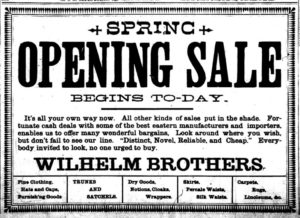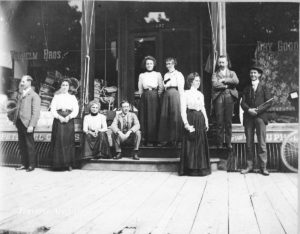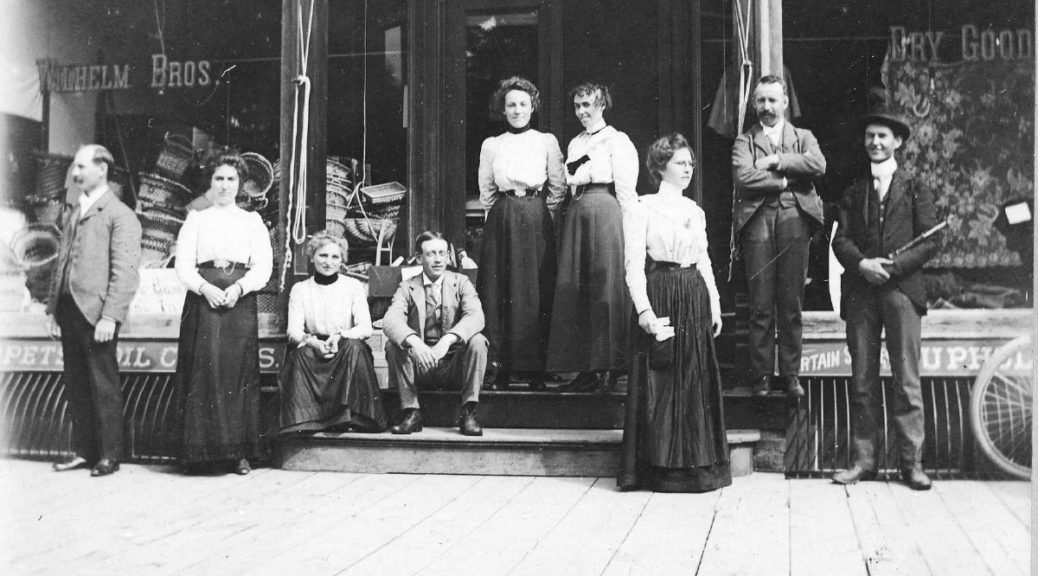By Robert D. Wilhelm
Part I in this series was published in the November 2016 issue of Grand Traverse Journal.
Edited by Julie Schopieray and Richard Fidler
[Editors note: This is a transcription of a manuscript Bob Wilhelm wrote over a long period of time, with updates ending in 1986. Some spelling and punctuation has been changed, and transcriber’s notes for clarity are in brackets]
CHAPTER 14: 116 East Eighth Street
When A.J. [Wilhelm] and Kate [Smith]were married in 1896, they lived above the store overlooking Union and Eighth streets. Five years earlier A.J. had purchased lots 33, 34 and the west 8 feet of Block 6 across from the store on East Eighth Street from A.V. Friederich for $700. A.J. and John Kyselka designed the house to be built on the site. Built of local pine, hemlock and birch, A.J. personally selected all the materials. The total cost for the home and the barn in the backyard was $3,000. A.J. lived in the home until his death in 1939. The Lyle Wilhelm family occupied the residence until 1974 when it was sold for use as the Northwestern Michigan Halfway House. In 1984 this home was joined with the former A.V. Friedrich residence, and in 1985 the merged buildings became the Dakoske Hall.
CHAPTER 15: Wilhelm Brothers, 1900
Depending on the time of the year, the store employed as many as twelve people. The clerks never made change. A cashier handled all the money. Overhead conveyor belts moved all bills and money to the central location. A bell indicated that the canister was coming or going. Kate Wilhelm handled all business records.
Early each morning it would be necessary to start the wood burning furnace and activate the steam boiler. Hardwoods, usually maple or oak, were cut in four foot sections. A large double door led to the basement where the wood was stored in the summer from floor to ceiling. Outside behind the store were other wood piles.

The building was illuminated by smelly kerosene lamps. At the back of the building was a double door leading to the main floor. The freight–which was shipped by boat or railroad–was delivered by Sam Ile’s horse and wagon. Towards the back of the newer section of the building was an eight-foot-wide staircase leading to the second floor. Carpets, rugs, and linoleum were sold upstairs. There was no elevator; everything had to be carried by hand up and down the stairs. On the street level, men’s and women’s clothing, dry goods and household goods were sold.
CHAPTER 16: A.J.—NATURAL FOODS AND ARTESIAN WATERS
Stomach disorders dating back to his youth caused A.J to develop an interest in the natural foods philosophy espoused by the Kelloggs at Battle Creek Sanitarium. Although there was no scientific evidence at the time, he became interested in the water conditions in the streets and the relation to disease. Dirty water mixed with manure was [thought to be] a breeding ground for typhoid and small pox. These diseases ran rampant through the community, but escaped the Wilhelm family. Raw sewage was dumped into the Boardman River and flowed into West Grand Traverse Bay. Untreated water was pumped through the mains into the homes. Diseases killed many children in their early years of life. Particularly disturbing to A.J. was the family of his friend and neighbors Prokop and Antonia Kyselka. Five children died young: Antonia B. (1869-1869), Antonia (1872-1872), Edward (1873-1875), Julius (1879-1883), and Emma (1890-1890).
One of the links to the death of the young was, when breast feeding stopped at an early age, the children were not immune to the diseases in the contaminated water and raw milk. Milk stored in unsanitary conditions resulted in undulant fever.
An artesian well is one that has its water constantly flowing. There were many people in the community who thought that artesian water was poisonous. In 1895 A.J. had a four-inch pipe drilled behind the store to a depth of 382 feet. The clear, clean water was a constant 42 degrees. The fountain was purchased from J.W. Fiske, NO 21 &23 Barklay Street, New York. Enough pressure was generated to provide water to the second floor of the store. Well water went to the home across the street. He had water running through the icebox instead of ice purchased from a local iceman. Water was also provided for the homes of Prokop Kyselka, A.V. Friedrich, and John Wilhelm. For many years people from all over the south side came with their jugs to get their water.
Other south side wells were also drilled: in front of St. Francis Church in 1916 and on Pine Street next to Central School.

As years passed, the flow of the well began to diminish. The water supply was cut off to all but the store and the family home. By 1955 the flow was no more than a trickle. The Record-Eagle on October 12 reported, “ The old Wilhelm well is gone…A year ago efforts were made to revive the dwindling flow of water, but to no avail. Several feet of rock had been forced up the four inch pipe and the only cure would be to drill an entirely new well. Thus the old well without mourners, or fanfare was removed.” [Editor’s note: The artesian well described here can be seen every year at the Buckley Old Engine Show].
Red meat was unknown at the Wilhelm dinner table. Chicken and fish were accepted and on special occasions such as Thanksgiving and Christmas turkey was served. A cow was kept in the barn behind the house and a neighborhood boy would take all the neighborhood cows to the outskirts of town for grazing each day. When the cow “dried out” it would be traded for another. A.J. referred to the milk as “home-made” because the whole milk was drunk right from the cow without being processed. Cream would rise to the top and was excellent for whipping. Butter was purchased from the Wheelocks because A. J. was pleased by the sanitary conditions of their farm. He refused to purchase food products if he was dissatisfied by the lack of cleanliness.
A favorite meal of the family was a high-protein meatloaf made from roasted peanuts. Honey was used instead of sugar. Nuts of all kinds were purchased in large quantities from Butler Brothers in Chicago. Peanuts were purchased to make peanut butter. A flat grinder made the peanuts finer and it was mixed with pure butter. Postum, made with roasted chicory and barley or wheat, was used instead of coffee. Vegetables were always served. Mary Smith (Mrs. Alec Rennie) recalled when she was in high school “Auntie Kate” always had a kettle of lima beans on the stove for her boys and her niece for lunch. Scalloped potatoes was another favorite. Bananas were purchased by the stalk and oranges by the crate from Peter Menegari at wholesale prices.
When A.J. wanted a watermelon, he would send one of the boys down to Front Street to the “I-talians”. His final instruction was to let Mr. Corsilla personally pick one out because he always picked one of the best quality.
A.J. purchased ten acres of land at the top of the hill on Silver Lake Road (across from the Junior High School [now, West Middle School]). Except for a small ramshackle shed and a well without a pump, the land was barren. He bought the land to have fresh fruits and vegetables for the family. It would also keep the boys busy and out of trouble. George and Lyle disliked the work. Ralph hated it. The boys could sell all the produce not needed by the family. Markets, usually Beemish and Nicholson, on the 500 block of South Union Street would purchase the surplus fruits and vegetables. A savings account was set up by their father at the First National Bank for each of the boys and all the farm profits were deposited. Lyle kept his money until 1929 when he sold his savings to a bank officer. The money was used to help purchase a home from the Emanuel Wilhelm estate at 425 W. Eighth street. The house was similar to A.J.’s home at 116 East Eighth. Two weeks after the sale, the bank declared insolvency. Ralph and George lost their savings in the “Great Depression”.
Every morning after finishing chores around the house, A.J. and the boys would mount the wagon, slowly pulled by the retired racehorse “Jack” and go to the farm.
A.J. was mild-mannered and never used profanity except when he was behind the plow horse and the boys learned “every word of interest”. It is doubtful if Kate ever knew of his farm vocabulary. With the exception of “Paris Green” (copper sulfate) used to kill potato bugs, sprays were not used. Corn, potatoes, red, black and yellow raspberries were grown. A grape arbor was assembled. Apple, cherry, pear, and peach trees were planted. One of the early lessons learned by the boys was never to plant cucumbers and melons too closely together.
One day a pig got out of Ben Barnes’ pen and started exploring the Wilhelm gardens. The boys chased the pig until the animal dropped dead. A.J. went over to the Barnes’ farm and paid for the dead animal.
Around noon each day the four would return back to town. The usually slow moving “jack” would once again remember his days as a race horse.
With all boys all in their teens, the farm was sold to the Thayers in 1915.
Traverse Area District Library does not have photographs of Anthony J., Kate, Lyle, Ralph or George Wilhelm. Any assistance in filling in this gap in our collection is appreciated! Please get in touch with librarian Amy, abarritt@tadl.org

